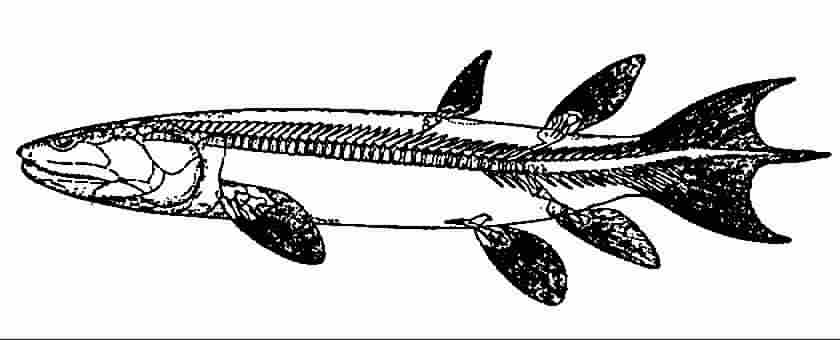

Usage: Many of our most basic gestures, postures, and bodily responses originated in paleocircuits of the aquatic brain and spinal cord. Though our nervous system has greatly evolved, paleocircuits for smell-related cues (see DISGUST), touch (see TACTILE WITHDRAWAL), locomotion (e.g., for the rhythmic, alternating movements of walking), and chemical arousal (as evident, e.g., in the FIGHT-OR-FLIGHT response) remain functionally the same today.
Sea view. Like life itself, nonverbal communication evolved in the sea. The first Ordovician cues given and received 500 m.y.a. targeted receptors for touch and smell in our remote oceanic ancestors. Deep in the aquatic brain and spinal cord of the jawless fishes, neural circuits evolved which process many of the wordless signs we send and receive today. Spinal and cranial nerves, e.g., continue to link sensory input with motor response in programming the outflow of nonverbal cues:
I. Spinal cord. The oldest proto-gestures can be traced to tactile-withdrawal spinal reflexes of the earliest known vertebrates. Based on studies of newly hatched fishes, e.g., it is likely that touching the skin of the earliest, now extinct animals would have elicited the same alternating, side-to-side flexion movements designed to remove swimmers from predators and to deliver them from harm's way (see CROUCH). "Rhythmic behavior includes walking, running, swimming, breathing, chewing, certain eye movements, shivering, and even scratching. The central pattern generators driving each of these activities share certain basic properties. At their core is a set of cyclic, coordinated timing signals that are generated by a cluster of interconnected neurons. These basic signals are used to command as many as several hundred muscles, each precisely contracting or relaxing during a particular phase of the cycle. . ." ("Circuits of the Central Nervous System," by Walter Boron, Medical Physiology, 2017; https://www.sciencedirect.com/topics/neuroscience/central-pattern-generator).
II. Hindbrain. The aquatic hindbrain sent signals to the spinal cord a. to maintain muscle tone, b. to control the excitability of cord reflexes, and c. to select cord paleocircuits for reflexive body movements and postures. A chemical storage area (comparable to our brain's locus ceruleus or "blue spot") was a primary source of the neurotransmitter, norepinephrine. Fiber-linked to the spinal cord below and to the forebrain above, this chemical was (and still is) important in regulating arousal. Today in humans, highly aroused spinal reflexes show, e.g., in faster and stronger body movements.
SUPPLEMENTARY NOTE: Another early chemical reservoir (comparable to our brain's raphe nuclei) was for serotonin. As old as vertebrates themselves--or even older--serotonin has been found in living crabs and lobsters. Injected into the bloodstream of a lobster, e.g., serotonin leads to an elevated body posture expressive of dominance. In our own nervous system, serotonin promotes the expression of confident body signs, such as squaring-up with a partner (see ANGULAR DISTANCE), returning eye contact, and smiling. (N.B.: By increasing serotonin levels, Prozac and similar drugs may decrease aversive [i.e., unfriendly, negative] signs, and increase affiliative [i.e., friendly, positive] cues.)
III. Midbrain. The aquatic midbrain had a chemical storage area for the neurotransmitter dopamine. Comparable to our own midbrain's substantia nigra (or "black spot"), it supplied dopamine to primitive motor centers of the striatal complex (still present in our basal ganglia), which influenced body movements for locomotion and for keeping upright in gravity's downward pull (see ANTIGRAVITY SIGN). Lowered dopamine levels in humans (caused, e.g., by Parkinson's disease) may show in an awkward shuffling gait, an expressionless face, and rotary trembling movements of the arms and hands (see AKINESIA).
IV. Forebrain. Incoming (or afferent) taste and aroma cues dominated the aquatic forebrain via fiberlinks from the amygdala to chemical-control areas of the hypothalamus. On the former's command, nuclei of the latter released neurohormones into the bloodstream, arousing body movements and postures of the fight-or-flight response.
See also AMPHIBIAN BRAIN.
Copyright 1998 - 2022 (David B. Givens/Center for Nonverbal Studies)
Illustration detail from Getting There (copyright 1993 by William
Howells)